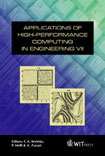Time-domain Laplace Transform Boundary Element Methods For Diffusion Problems
Price
Free (open access)
Volume
27
Pages
Published
2002
Size
421 kb
Paper DOI
10.2495/HPC020071
Copyright
WIT Press
Author(s)
A. J. Davies & M. E. Honnor
Abstract
Time-domain Laplace transform boundary element methods for diffusion problems A. J. Davies and M. E. Honnor Mathematics Department, University of Hertfordshire, UK. Abstract In the solution of diffusion-type problems the Laplace transform method in time provides an alternative to the finite difference method. The advantages compared with the finite difference method are that there is no time-step stability problem and if the solution is required at just one time value then there is no need for the computation of solutions at intermediate times. From a variety of numerical techniques available for the numerical inversion, Stehfest’s method has been the numerical inversion process chosen by most authors in association with the boundary element method. The procedure has been successfully implemented on a distributed memory architecture using a ‘Single Program Multiple Data’ paradigm on a 512-processor nCUBE machine arranged in a hypercube configuration. The Laplace transform method is applicable to linear problems, for non-linear problems a suitable linearisation process is required. 1. Introduction The Laplace transform solution method for time-dependent diffusion-type problems, transforming a parabolic problem in time to an elliptic problem in the transform space, has been considered by a variety of authors1…7. A variety of techniques may be employed to solve the resulting elliptic problem e.g. Davies et a1.8 compare the finite difference method, the finite element method, the boundary element method, the method of fundamental solutions and the multiquadric method. Rizzo and Shippy9 first used the Laplace transform in conjunction with the boundary integral equation method using an inversion process in terms of a Prony series of negative exponentials in time. Stefhest’s method, which is much simpler to apply, was first used by Moridis and Reddell2. The suitability of this particular method for developments in a parallel
Keywords




